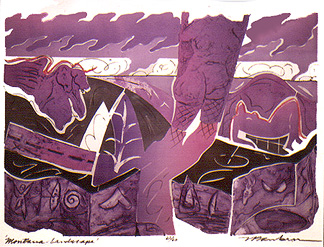| "Montana
Landscape" by Jerry Rankin
|
Jerry Rankin Collagraph, 1988 Jerry Rankin is an artist who seeks to avoid standard catalog definitions of his life. "Suffice it to say that my roots are in the West." A graduate of Montana State University with a B.S. in Applied Art and an M.F.A. from the University of Montana, he considers himself an artist-educator, having taught in Washington, Alaska and Montana. He has been working as a full-time artist since 1985. He reveres his friendships with colleagues like Rudy and Lela Autio, Bob and Gennie DeWeese and Don Bunse, "beacons guiding me onward." Rankin differentiates himself from traditional Western artists who "might choose to romanticize a particular epoch" and finds himself far more interested in "Marcel Duchamp's influence on American art. My metaphors build on classical references. I might discover a Matisse Odalisque fitting comfortably into a landscape, or a winged Nike!" "Flattered" to be part of the Rattlesnake Valley Press Centennial Portfolio, he states he is "honored to be included among the chosen tribesmen." In his piece for the Portfolio Rankin's sense of himself as an of archivist of myth and reality is apparent. Art historical references - which Rankin sees as his point of departure from the traditional Western artists - abound. He admits this vocabulary of images is very "personalized" but they serve as discords to pull the viewer "into a new sensibility" about the print. For example, could the double Pegasus not be a "working team...freed!" or the nude a "remnant of the frontier dance hall?" And the images scattered throughout the references to geologic strata are to Rankin possible symbols for "ancestral graves." Rankin's eclecticism marries a selection of energized forms and colors to create an image of the West at once regional and universal. This special blend marks Rankin's work as a unique example of both contemporary and western art - work he believes reveals that "connective thread tying me to the West - or to the world." --From the Rattlesnake Valley Press Centennial Issue, 1989, Margaret Mudd |

